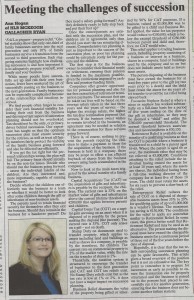HLB McKeogh Gallagher Ryan’s Anne Hogan advises on the best approach to succession planning
“Fail to prepare – prepare to fail”. Global statistics show that only one third of family businesses survive into the next generation and only one  tenth of family businesses survive a transition from the second to the third generation. Such staggering statistics highlight how challenging succession is and how important it is to adequately prepare –yourself, your family and your business.
tenth of family businesses survive a transition from the second to the third generation. Such staggering statistics highlight how challenging succession is and how important it is to adequately prepare –yourself, your family and your business.
While many people have successfully set-up and run their own businesses, fewer have mastered the art of successfully passing on the business to the next generation; family businesses can be especially complicated because of the relationships and emotions involved.
We find people often forget to consider their own financial stability following their exit from the business – this important aspect of succession planning should not be overlooked. Tax should not be the only, or primary, driver behind succession. Our experience has taught us that the optimum succession plan must ensure security for the retirees as well as treat all family members fairly; protect the viability of the family business going forward, and also be effected tax efficiently.
If you get the tax right but the personal relationships wrong the plan will fail. The primary focus should initially be on the non-tax issues. Decide who should run the business going forward – assess the individual talents of the children. Are they interested, and more importantly capable, of running the business?
Decide whether the children can effectively run the business as a team or whether it would be better to look after some children through the gift or inheritance of non-business assets.
The parents need to retain financial security for themselves after they exit the business. Should they remain in the business for a handover period? Do they need a salary going forward? Are they definitely ready to fully step back and put their feet up?
Once the owner/parents are satisfied with the succession plan, and the children are in agreement, only then should you start the tax structuring element. Comprehensive tax planning is just as important to the success of the succession plan, as poor tax planning could be extremely costly for the parents and the children.
The first step is for the business owner to consider their financial needs on retirement, ensuring their pension is funded to the maximum possible, given the restrictions imposed by cashflow and pension-funding limits.
Companies offer greater opportunities for pension planning and also for tax-free extraction of retirement termination payments. The amount that can be taken tax free will be based on the average salary taken in the last three years and the years of service – the higher the average salary, the higher the tax-free termination payment that accrues. If the business owner wishes to remain involved in the business an agreement may be needed re: the remuneration for these services going forward.
There is of course nothing to prevent the parents requiring the children to make a payment to them for the acquisition of the business. If the business is held in a company there may be scope to effect a tax efficient buyback of shares from the business owners using funds accumulated in the company.
And now to look at the main taxes triggered by the actual transfer of a family business.
Capital Acquisitions Tax (“CAT”) on the acquisition of gifts and inheritances, is payable by the recipient i.e. the children. The current rate is 33% on the market value of gifts and inheritances above the current lifetime threshold of €280,000 that applies between parents and children. .
Capital Gains Tax (“CGT”) on a capital gain accruing on an asset when it is disposed of, is payable by the person making the disposal (i.e. the parents). The current rate is 33%. CGT only arises on a gift –not on death.
Stamp Duty on documents used to transfer property, (which applies to assets including land and buildings as well as shares in a company), is payable by the transferee i.e. the children. The current rate on commercial property is 2% of the market value, the rate on the transfer of shares is 1%.
Thankfully the taxation system is structured to encourage the transfer of businesses to the next generation and CAT and CGT tax reliefs exist. No Stamp Duty reliefs exist but as the tax rate is low at 1%/2% it does not have a major impact on succession planning.
Business Relief discounts the value of the property being gifted or inherited by 90% for CAT purposes. If a business valued at €1,000,000 was to be gifted to a child and Business Relief applied the value for tax purposes would reduce to €100,000 which is below the exempt threshold of €280,000 between parent and child and therefore no CAT would arise.
This relief applies to trading business assets including property consisting of a business or interest in a business, shares in a company, land or buildings used by the company etc. but does not include assets held as investment assets.
The person disposing of the business must have owned the business for at least five years prior to the gift (or two years prior to a death) and the child must retain the assets for six years after transfer to avoid the tax relief being clawed back.
Favourite Nephew Relief, if a niece or nephew has worked substantially on a full-time basis for a period of five years ending on the date of the gift or inheritance they may be deemed a “child” and utilise the €280,000 parent/child threshold (the normal threshold between aunts/uncles and nieces/nephews is €30,150).
Retirement Relief is available on the transfer of a qualifying business so that no CGT is payable where a business is transferred to a child by a parent aged 55-65. Where the parent is aged 66 or over the maximum value that may be tax relieved is €3,000,000. Conditions attaching to the relief include the individual having owned the assets for at least ten years and, where the assets are shares, the individual having been a full time working director of the company for at least five of those ten years. The child must retain the assets for six years to prevent a clawback of the relief.
Entrepreneur Relief reduces the rate of CGT on a disposal of chargeable business assets from 33% to 20% for qualifying gains of up to €1,000,000 in a vendor’s lifetime. The maximum tax saving is €130,000. The conditions for the relief to apply are somewhat similar to Retirement Relief. In some cases this gives a better result that Retirement Relief and may be used as an alternative. The person making the disposal must have owned the chargeable business assets for a continuous period of three out of the five years before the date of disposal.
Hopefully it is clear that the tax reliefs surrounding succession planning can be quite favourable. This article gives a broad overview of the position but it is not an exhaustive list. The key point to remember is to prepare for succession as early as possible to ensure the transaction can be properly structured and the business is passed on to the persons best placed to successfully run it for another generation, ensuring that the business does not become another failure statistic.
If you have any queries on the contents of this article please contact Anne Hogan Associate Tax Director or a member of HLB McKeogh Gallagher Ryan’s Tax Department on 061-208050.
This article appeared in the Clare Champion on Friday 22 July 2016.
